Could NASCAR ‘ruin’ another IndyCar race?
By Asher Fair

Recent IndyCar races at Texas Motor Speedway have seen relatively poor quality thanks to the PJ1 traction compound used for NASCAR races.
IndyCar races at Texas Motor Speedway have historically been some of the best events on the calendar, with many lead changes, last-lap passes, photo finishes, cars going three and four-wide in parts of the track, and more.
But lately, they have been among the more lackluster events on the calendar, a frustration made worse by the fact that oval races are as sparse as they’ve ever been.
Also. Danica Patrick's worst crash. light
The driving factor behind this overall drop in quality of racing around the four-turn, 1.44-mile (2.317-kilometer) oval in Fort Worth, Texas, which was repaved and reconfigured in 2017, has been the application of the PJ1 traction compound designed to improve grip in the higher lanes and make NASCAR races more exciting.
Most NASCAR fans will tell you that even this hasn’t been too much of a help here, as Texas Motor Speedway is among the tracks on the Cup Series calendar most often mentioned when it comes to potential venues to remove from the calendar.
Regardless of your opinion on the stock car event, the PJ1 has the exact opposite effect for IndyCar.
Venturing onto the slippery, dark surface is practically a sure way to end up in the wall, as several drivers have found out the hard way in recent years. As a result, despite the width of the track, there hasn’t been a viable second lane in the corners for the open-wheel cars.
It’s not as simple as “scrubbing it off” as some might suggest, and this lack of ability to remove it has led to single-file processions, completely uncharacteristic of what superspeedway racing should be.
Scott Dixon led 157 of 200 laps en route to a 4.411-second victory there in 2020, when the top three starters all finished inside the top three. The race only got interesting when teammate Felix Rosenqvist began to close what was roughly a half-lap lead late in the race, only to crash due to barely getting into the no-go zone.
In the first race there in 2021, Dixon led 206 of 212 laps. He never relinquished the lead, save for during pit stops, after taking it from teammate Alex Palou on lap three.
The second race at the track in 2021 was a bit more exciting with more lead changes than the track had seen in the previous two races combined, but Dixon still led 163 of the first 185 laps.
And it’s not as simple as drivers being “unwilling to take risks”, either. It is, quite literally, nothing more than the fact that drivers don’t want to guarantee crashing.
Fortunately, according to RACER’s Marshall Pruett, there are three potential solutions that IndyCar has come up with, solutions that are long overdue, ahead of this Sunday’s 248-lap XPEL 375 at the track to hopefully make it far more exciting than races at the track in years past.
But is it too little, too late?
Texas Motor Speedway has hosted at least one IndyCar race per year since 1997, with a total of 34 races, including two last year for the first time since 2011, in 25 years. But there is uncertainty about whether the track will return to the schedule beyond this weekend.
Next. Top 25 IndyCar drivers of all-time. dark
Hopefully, whether this ends up being the final race at the track or not, it is better than anything the track has produced for IndyCar in recent years. Tune in to NBC at 12:30 p.m. ET on Sunday, March 20 for the live broadcast of the XPEL 375 from Texas Motor Speedway, the second of 17 races on the 2022 schedule. Start your free trial of FuboTV today!